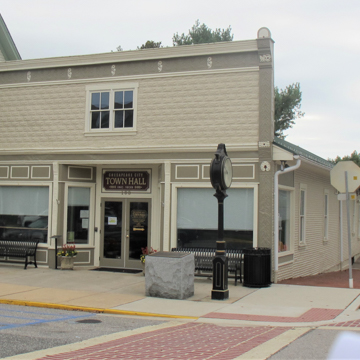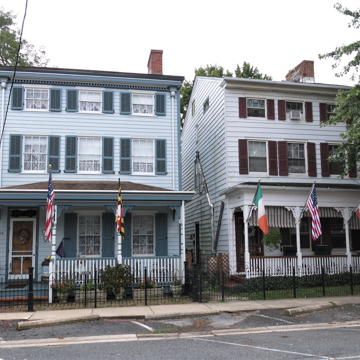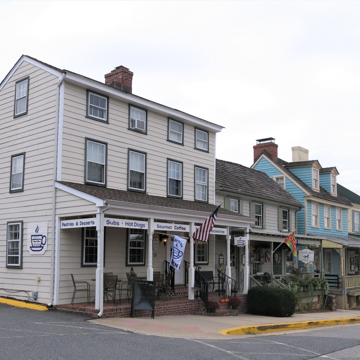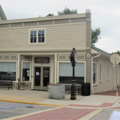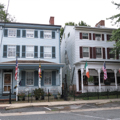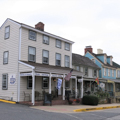Leading inland from Back Creek, Bohemia Avenue is Chesapeake City’s principal commercial street, extending from the waterfront and former boat landing site to the south side of town. Noteworthy buildings include the imposing Franklin Hall (c. 1870; 20 Bohemia), a three-and-a-half-story, gable-front brick commercial building. It was erected by local builder Thomas Conrey to encompass offices on the upper floors and first-floor retail space used historically by hardware dealers Bowen and Boulden. Other noted retail buildings are the quintessential gable-front J. M. Reed Store (c. 1870; 100 Bohemia), a dry goods business that claimed the greatest selection in town, brought via steamboat from Baltimore and Philadelphia. Rees Hardware Store (c. 1912; 108 Bohemia) is typical of early-twentieth-century design and materials featuring a false front of pressed metal manufactured by George L. Mesker Iron Works of Evansville, Indiana. Boasting a more elaborate Mesker facade is the former grocery and general merchandise store (c. 1880; 222 Bohemia) operated by Byron Bouchelle.
Houses of note include the ornamental Brady House (1876; 104 Bohemia), embracing a cross-gable roof, bracketed crowned bays, and jigsawn porch. It was built for Henry H. Brady, who ran a fleet of tugboats, operating out of the small frame and brick-nogged office adjacent to the house. A Second Empire house (c. 1870) at number 216 was erected by builder Thomas Conrey as his own residence. Representing a common Chesapeake City dwelling form are numerous three-story, three-bay, side-hall plan houses with a distinctive upper level of half-story windows. The best preserved and oldest was built for Firman Layman (1848; 204 Bohemia), who operated the canal-front Bayard House Hotel (c. 1800; 11 Bohemia). Likewise are the houses of steamboat captains Abraham L. Colmary (c. 1848; 206 Bohemia) and John Clark (c. 1856) at number 211, and of physician William C. Karsner (c. 1884) at number 214. The finest is the 1872 house of Chesapeake and Delaware Canal executive Joseph Hedrick (301 George Street).


